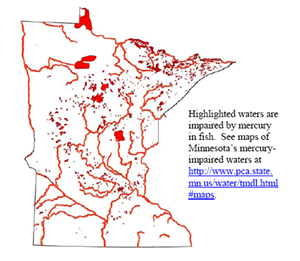
A recent commentary by Minnesota Pollution Control Agency Commissioner John Linc Stine (“The MPCA’s mercury move, explained,” April 22), argued that when it comes to mercury pollution, there is “a debate about tactics, not whether to take action.” But two recent choices demonstrate a stunning lack of urgency on the part of Minnesota government.
“a debate about tactics, not whether to take action.” But two recent choices demonstrate a stunning lack of urgency on the part of Minnesota government.
The MPCA’s choice to withdraw from a four-year study of mercury pollution in the St. Louis River, as well as a decision by the Minnesota Department of Natural Resources allowing Minntac to expand iron ore mining without an environmental-impact study are not supported by objective evidence.
Together, they suggest that Gov. Mark Dayton is interested in the financial health of mining companies rather than in the health of Minnesota’s pregnant women, children and the environment.
In his commentary, Stine knocked down a series of straw-person arguments while ignoring the most critical issues.
• Debate over mercury: There is no debate among scientists with the central premise. Mercury, in any amount, is a neurotoxin for developing children. A nontoxic level of exposure has never been documented. If there is a debate about anything, it is over why current guidelines aren’t revised with lower allowable exposure limits.
Does the MPCA really have independent science on mercury that is superior to the data and experiences of the U.S. Environmental Protection Agency and independent researchers? That seems a stretch. And even if it is true that the St. Louis River has unique factors that influence the availability of mercury, that’s no reason to withdraw from studying these factors alongside the EPA.
• The science just isn’t there: The tobacco industry used this argument for 50 years before the U.S. Department of Justice found it guilty of violating federal antiracketeering laws. Science is a moving target. There will never be a “final answer” to questions about mercury or any other environmental toxin. The question is whether there is sufficient evidence from multiple sources, over time, in different locations and populations, that mercury exposure causes human disease. The answer is yes. The MPCA and legislators should use the “ounce of prevention is worth a pound of cure” rule and show leadership by establishing policies that maximize the elimination of human contributions of mercury to Minnesota waterways.
• Minnesota is ahead of the pace: This doesn’t mean that the state is meeting best evidence from current independent scientists and experts. Many researchers suggest lower allowable limits for individual metals because of the likely exposure of children and adults to multiple neurotoxins in daily life. Minnesota would be showing leadership if it chose 2020 rather than 2025 for its goal of 93 percent reduction. That would be achievable and would provide an enormous benefit for our future generation’s developing brains.
When one in 10 infants on the North Shore of Lake Superior have unsafe levels of mercury in their blood, it is imperative to take action. The science of mercury toxicity is robust and indisputable, with high levels of vulnerability for pregnant women and children whose rapidly growing brains are sensitive to even small concentrations of mercury.
Stine’s argument that the EPA’s approach to studying the St. Louis River would lead us “in the wrong direction” should be more honest. Failing to evaluate the Minntac expansion and withdrawing from the St. Louis River mercury study suggests that Minnesota will go in any direction to reduce mercury — unless that direction leads us to scrutinize the mining industry.
————————-
Stephen J. Jay, of Indianapolis, is a physician and a property owner near Ely, Minn.

Leave a Reply